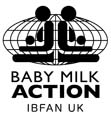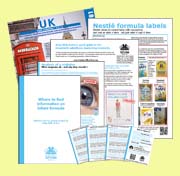Malnutrition - a new market
Danone off GAIN Board but risks remain
Our campaign to have Danone removed from the Board of the UN Business Partnership, the Global Fund for Improved Nutrition (GAIN) (see Update 41) succeeded in July. However, Danone, Pepsico and other food companies still sit on GAIN’s Business Alliance Global Forum, benefitting from GAIN’s philanthropic image and its UN partners such as UNICEF. Although GAIN claims to promote breastfeeding, its market-led approach is helping food companies fuel a craze for fortified foods and micronutrients. Under the banner of ‘enlightened self interest’ and ‘wellness’ many are busily repositioning their products as health foods.1 Indeed Nestlé says in the Economist (29.10.09)2 “the defensiveness of the past is gone, Now we have a noble cause.” In the absence of strong national regulations in many countries, we wonder how GAIN will independently monitor and ensure the safety, quality & delivery of its industry initiatives or prevent attention being diverted from essential interventions like breastfeeding, access to clean, potable water, sanitation & sustainable complementary feeding?
1. Welfare Inc R.Nagarajan Times Insight Group (Times of India) Crest 24.10.09 http://m.timesofindia.com/PDATOI/articleshow/5156400.cms
2. The unrepentent chocolatier www.economist.com/displaystory.cfm?story_id=14744982
Industry influences national delegations
We are calling for all food industry representatives to come off government delegations to the global food standard setting body, Codex Alimentarius. Industry delegates can outnumber government delegates and can even lead delegations. At the Thai Codex Nutrition meeting in Nov 2006, of the 200 delegates over 100 were from industry, half of them on government delegations. We are also keeping a watch on GAIN, which now has Observer status at Codex - sitting right next to us in Nov 09, where it lobbied, through Ghana, for guidelines to “lessen impediments to international trade” in ‘formulated complementary foods.’
This will include branded fortified foods and supplements allegedly marketed for the prevention (not the cure) of malnutrition. In IRINNews, Stéphane Doyon, Médecins Sans Frontières expressed concern about patents: “The patents are so broad that if you add one micronutrient into a jar of Nutella [a widely distributed brand of nut pastes] it will fall within the patent.”3 A briefing on the new foods will be available as a download ASAP.
3. Making peanut butter gets stickier www.irinnews.org/report.aspx?ReportID=86979
GSK PUSHING MICRONUTRIENTS and obesity in India
We spoke at the Global Conference on Meeting Nutritional Challenges with Sustainability and Equity in Delhi in August, alongside Vandana Shiva and Marion Nestle who showed how companies are pushing micronutrients in junk foods.

A Pre-School Guide for Parents, that we picked up in Delhi, contains 52 pages of adverts with claims such as: “Lack of micronutrients in young children can delay language development” (see above). Because the ‘right’ answers in an accompanying quiz are unattainable, parents will get a low score. Their children will be ‘picky eaters’ in need of Glaxo Smith Kline’s very sweet Junior Horlicks every day. A web promotion for Mothers Horlicks claims that “DHA is not easily available from average indian Diet.” The DHA is made by Martek.
For the People’s Charter for Food and Nutrition Security see: www.ibfanasia.org/gc/Peoples-Charter-for-Food-and-Nutrition-Security.pdf






